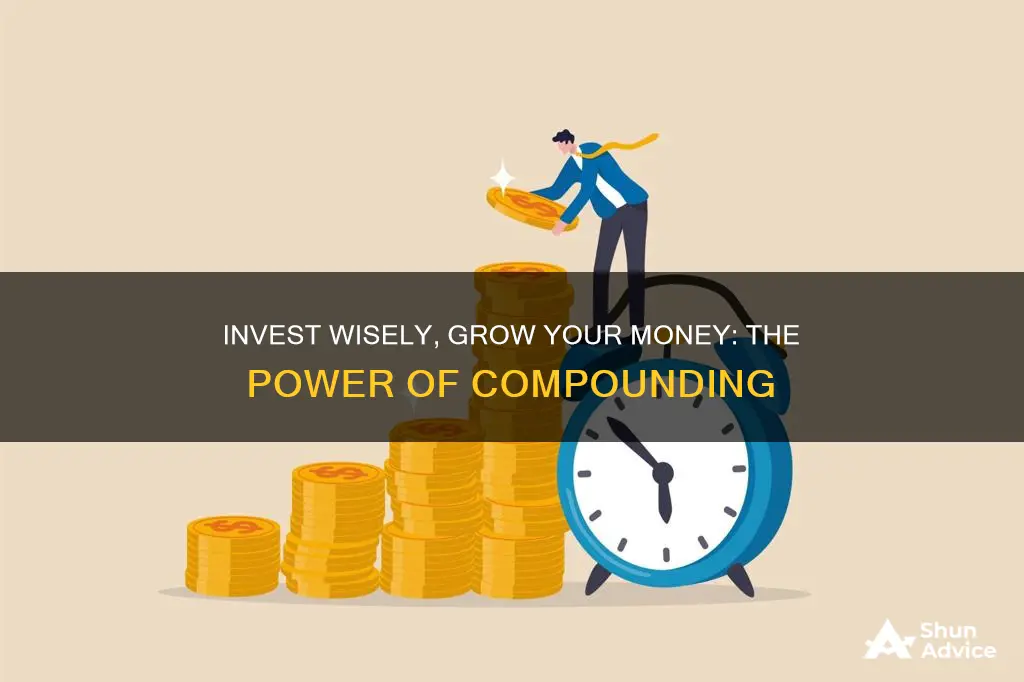
Compound interest is a powerful investing concept that can help your money grow exponentially over time. It involves reinvesting returns on your original investment, along with the returns you received previously. This process of compounding can multiply your initial investment and accelerate your wealth accumulation. For example, if you invest $1,000 and earn a 6% rate of return in the first year, you would make $60, bringing your total investment to $1,060. In the next year, you would earn a return on the total $1,060. If the return remains at 6%, you would make $63.60, resulting in a total investment of $1,123.60. This cycle of compounding continues, and with time, your investment can experience remarkable growth. To benefit from the power of compounding, it is essential to start investing early, be consistent, and reinvest any dividends or profits.
| Characteristics | Values |
|---|---|
| Compounding | Reinvesting the returns from your initial investment back into your account |
| Compounding Process | Reinvesting the interest earned on the initial investment |
| Compound Interest | Earning interest on both your original investment and returns |
| Compound Growth | When your money grows, the new money that you’ve made will also grow if you keep it invested |
| Compound Interest Calculation | Many financial calculators and online tools can calculate compound interest; the basic formula is: P = Initial principal amount; r = Interest rate (as a decimal); t = Period (in years) |
| Rule of 72 | You can estimate the number of years it takes for your money to double at a certain interest rate by dividing 72 by the interest rate |
| Reinvesting Dividends and Interest | Reinvesting dividends and interest earned from your investments |
| Tax-Advantaged Accounts | 401(k), Roth IRA, and health savings accounts (HSAs) |
| Consistency | The cornerstone of compounding interest; the more steadfastly you invest, the greater the time your money has to flourish |
| Time | The earlier you begin investing, the greater the advantage of compounding |
What You'll Learn

Reinvest your profits
Reinvesting your profits is a powerful way to make your money work for you and accelerate your journey towards financial freedom. When you reinvest your profits, you put your earnings back into your investments, allowing them to generate even more returns. This is the essence of compound growth—the idea that your money grows, and then that new money also grows if you keep it invested.
For example, let's say you invest $1,000 and earn a 6% rate of return in the first year, bringing your total to $1,060. If you reinvest this return, in the second year, you will earn a return on the total $1,060. If the return remains at 6%, you will make $63.60, resulting in a total investment of $1,123.60. This process can continue year after year, and the power of compounding will lead to exponential growth over time.
To illustrate the impact of compounding, consider this: if you keep reinvesting a $1,000 investment with a consistent 6% annual return, by the 30th year, your annual earnings will be $325.10. This is more than five times the $60 return you would have earned in the first year. This example demonstrates how compound growth can multiply your initial investment over the long term.
There are several ways to reinvest your profits. One method is to manually deposit your earnings into your investment account and purchase additional shares. Another option is to enrol in a dividend reinvestment plan (DRIP) or an automatic investment plan (AIP). These plans simplify the process by automatically reinvesting your earnings, helping you stay disciplined and capitalise on the benefits of compounding.
It's important to remember that reinvesting your profits is just one aspect of a broader investment strategy. Consistency and patience are also crucial. Even if you can only contribute a small amount each month, it will accumulate significantly over time thanks to the power of compounding. Additionally, consider starting early in your investment journey, as time is a crucial factor in maximising the benefits of compound growth.
Artificial Intelligence in India: Investment Opportunities and Strategies
You may want to see also

Start investing early
The key to unlocking the full potential of compound interest is to start investing early. The sooner you begin saving and investing, the longer your money has to compound and grow.
Consider a scenario where you make an initial investment of $5,000, with 5% interest compounded monthly. You will also make a monthly contribution of $100 to the investment account. After ten years, your investment will have grown to $23,763.28. Now, consider that in the same scenario, your investment will have grown to $105,565.59 after thirty years. That extra twenty years of compound interest, thanks to starting your investments early, makes a significant difference.
The foundation for building wealth lies in investing early. By starting early, your money has more time to grow and benefit from compounding interest. This compounding effect occurs as your investment earns interest, and then that interest, in turn, earns interest on itself. Over time, this can significantly boost the growth of your investment.
Moreover, early investing lays the groundwork for financial security. Building a nest egg provides a financial safety net for emergencies, granting you the freedom to pursue your passions and goals without financial worries.
For example, let's say you invest Rs 10,000 and earn a five per cent return each year. After one year, your investment will be worth Rs 10,500. But if you reinvest that Rs 500 of interest, your investment will now be worth Rs 11,025 the following year. This is because the interest earned in the first year is now earning interest in the second year.
The longer your investment duration, the more advantageous compounding becomes. With more time for your investment to earn interest and for that interest to further generate additional interest, the compounding effect strengthens in your favour.
Dine Equity: A Smart Investment for Long-Term Growth
You may want to see also

Invest in stocks or funds with higher returns
Investing in stocks or funds with higher returns is a great way to make your money work for you and build wealth over time. Here are some tips to help you get started:
Understand Compound Growth
Compound growth is a powerful investing concept that allows your money to grow exponentially over time. When you invest in stocks or funds, compound growth means that not only does your initial investment grow in value, but any returns or profits you make on that investment will also generate their own returns. This means that your wealth can increase at an accelerating rate, even without you contributing any additional funds. To take advantage of compound growth, it is important to reinvest any returns back into your investments rather than spending them.
Choose the Right Investments
Not all stocks and funds are created equal. When looking for investments with higher returns, consider the following:
- Risk and return: Generally, the higher the potential return, the higher the risk of loss. Be sure to carefully research any investment before committing your money and consider diversifying your portfolio to spread out the risk.
- Long-term growth: While some investments may offer quick profits, focus on those with strong long-term growth potential. Historical data shows that stocks have consistently outperformed most other investment types over long periods, with average annual returns of around 9-10%.
- Diversification: To reduce risk, consider investing in a variety of stocks or funds, such as exchange-traded funds (ETFs) or mutual funds, which pool your money with other investors to buy a diverse range of securities. This way, if one of your individual investments performs poorly, it won't devastate your entire portfolio.
- Index funds: Index funds are a type of mutual fund that tracks a market index, such as the S&P 500. They tend to have lower fees and are based on a long-term strategy of relying on the market to outperform single investments.
- Dividend stocks: Some stocks pay out regular dividends, which can provide a stable income stream and make them attractive to investors. Dividend stocks are often associated with more established, profitable companies.
Start Early and Be Patient
Compound growth relies on the power of time. The earlier you start investing, the more time your money has to grow. It's important to be patient and avoid withdrawing your funds, even when they start to grow. Remember that investing is a long-term strategy, and short-term market fluctuations are to be expected.
Regularly Add to Your Investments
While compound growth can help your existing investments grow, regularly contributing additional funds will further accelerate your wealth accumulation. Consider setting up automatic transfers or direct deposits to build your investment portfolio over time.
Investing in Tadawul from India: A Comprehensive Guide
You may want to see also

Reinvest dividends and interest
One of the most important strategies to maximize the power of compound interest is to reinvest dividends and interest earned from your investments. Instead of pocketing these earnings, reinvesting them allows you to take advantage of compounding on your growing account balance.
For example, if you own stocks that pay dividends, you can use those dividends to purchase additional shares of the same stock. Over time, this may significantly boost your investment returns as the reinvested dividends also generate their own dividends, creating a snowball effect of wealth accumulation. This is a powerful aspect of compound interest, especially considering your initial investment. In a way, it’s like growing money—if you manage your investments correctly in the right type of accounts.
There are several methods for reinvesting dividends and interest. You can manually deposit the earnings into your investment account and purchase additional shares. Alternatively, you can opt for a dividend reinvestment plan (DRIP) or an automatic investment plan (AIP). These plans automatically reinvest your earnings, simplifying the process and enabling you to remain disciplined while capitalizing on compounding benefits.
The longer your investment duration, the more advantageous compounding becomes. With more time, your investment can earn interest, and that interest can generate additional interest. This compounding effect strengthens in your favour over time. Therefore, it is beneficial to start investing early in life. The earlier you begin, even with modest amounts, the greater the advantage of compounding. By starting early, your money has more time to grow and benefit from compounding interest, setting you on the path to financial freedom.
It is also important to remember that reinvesting your profits can turbocharge your investment returns. When you reinvest your earnings, you effectively acquire more shares of the investment, increasing your ownership and future earnings potential.
Unlocking Private Equity: A Guide to Smart Investing
You may want to see also

Be patient and consistent
Time is a crucial factor in making compound interest work for you. Patience and consistency are essential if you want to maximise your returns. You won't see results overnight, so it's important to adopt a long-term perspective and remain disciplined. Remember that significant returns take time, and you must keep contributing to see your investments grow.
Stay committed to your savings and investment goals, even during periods of market volatility or economic uncertainty. Maintain a consistent investment strategy and avoid the temptation to time the market. By doing so, you can maximise the benefits of compound interest and achieve your financial objectives.
The effects of compounding may seem modest at first, but they become increasingly powerful over time. With the right mindset, smart investing, and an understanding of tax implications, compound interest can turbocharge your efforts to grow your savings and investments.
The key to unlocking the full potential of compound interest is to start early. The sooner you begin saving and investing, the longer your money has to compound and grow. For example, consider investing $5,000 with 5% interest compounded monthly, with a monthly contribution of $100. After ten years, your investment will have grown to $23,763.28. After thirty years, it will have grown to $105,565.59. That extra twenty years of compound interest, thanks to starting early, makes a significant difference.
Invit Investment Guide for Indians: Getting Started
You may want to see also
Frequently asked questions
Compound growth is a financial concept where you reinvest the returns generated on your initial investment, leading to exponential growth over time. This means that not only does your original investment grow, but the returns generated also grow, resulting in even larger gains.
Compound growth relies on reinvesting your returns back into your account. For example, if you invest $1,000 and earn a 6% rate of return in the first year, you would make $60, bringing your total investment to $1,060. In the second year, you would earn a return on the new total of $1,060. If the return rate remains at 6%, you would make $63.60, resulting in a total investment value of $1,123.60.
Start investing early, as time is a crucial factor in compound growth. Be consistent with your investments, even if the amounts are modest. Reinvest any profits or dividends to further boost your returns. Consider investing in options that compound more frequently, such as those that compound interest quarterly instead of annually.
Compound growth allows your money to grow at an accelerated rate over time, helping you build wealth and achieve your financial goals. It turns small initial investments into substantial amounts, making your money work harder for you.







